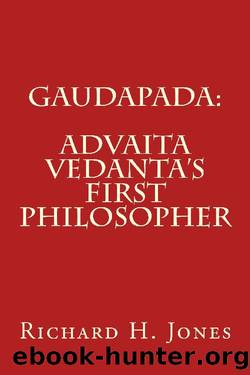Gaudapada: Advaita Vedanta's First Philosopher by Richard Jones

Author:Richard Jones [Jones, Richard]
Language: eng
Format: epub
Publisher: Jackson Square Books
Published: 2014-09-07T18:30:00+00:00
~
The Philosophy of the Gauda School ~
The Basics The ontology of the Gauda School could not be simpler: there is only one reality â Brahman, or the term Gaudapada more commonly uses, the Self (atman). In the words of the Upanishads, âAll this is Brahmanâ (ManU 2). There is no second reality. All sense of something being other than Brahman and all sense of multiplicity has no more reality than the characters and the objects in a dream.1The basic duality of a perceiver and the perceived is overcome: all is really consciousness (chitta). Their apparent duality and the apparent diversity of the phenomena of the world are the result of the âvibration (spandita)â of this consciousness transcending the âdream.â Nothing is nonconscious (achitta). Nothing real is created, nothing changes or is born â all the subjective and objective phenomena of our apparent world is only the shimmering of an eternal, unborn, formless, permanently present, immutable, contentless transcendent consciousness.
F. H. Bradley states the dilemma that change presents: âSomething, A, changes, and therefore it cannot be permanent. On the other hand, if A is not permanent, what is it that changes? It will no longer be A, but something else (1893: 40).â Advaitins answer the question by denying any change is real. (Buddhists answer by denying anything exists in the sense of being permanent.) The Advaita criterion for what isreal is what is permanent, eternal, and unchanging. To them, nothing could exist without such a reality. Anything that appears to exist but did not exist inthe past or ceases to exists in the future does not truly exist now. The criterion is not causal efficacy or anything else but that there is a metaphysical âsubstanceâ that must be common to all phenomena. Advaitins assert that only the transcendent
1 There are no means except analogies from the realm that we know dualistically to explain something transcendent to the unenlightened. Analogies by their very nature are limited. But the dreamer/dream analogy does actually work as the key to understanding the Gauda schoolâs ontology. Since the snake in the rope/snake analogy (GK 2.17) is not real, it does not work for ontological purposes, but it is a key to understanding the Gaudaâs theory of perception and epistemology.
43
consciousness is the unchanging reality in all the internal and external phenomena of our world and therefore it is that âsubstance.â Materialists would reply that if there is anything does not change it is the sum total of matter/energy in the universe and that consciousness is somehow constituted by that. But by interpreting all of the phenomenal realm as a âdreamâ projected through Brahmanâs creative power (maya), Advaitins can see consciousness as the one constant in all phenomena. Nothing material is actually created or emanated from Brahman: all of the phenomenal realm is only a vibration (spandita) of consciousness, and the sense that it is a second reality independent of Brahman and populated with multiple independent objects is what causes our misguided desires and hence suffering. Brahman is not
Download
This site does not store any files on its server. We only index and link to content provided by other sites. Please contact the content providers to delete copyright contents if any and email us, we'll remove relevant links or contents immediately.
The remains of the day by Kazuo Ishiguro(8819)
Tools of Titans by Timothy Ferriss(8216)
Giovanni's Room by James Baldwin(7189)
The Black Swan by Nassim Nicholas Taleb(7010)
Inner Engineering: A Yogi's Guide to Joy by Sadhguru(6724)
The Way of Zen by Alan W. Watts(6505)
Asking the Right Questions: A Guide to Critical Thinking by M. Neil Browne & Stuart M. Keeley(5632)
The Power of Now: A Guide to Spiritual Enlightenment by Eckhart Tolle(5604)
The Six Wives Of Henry VIII (WOMEN IN HISTORY) by Fraser Antonia(5394)
Astrophysics for People in a Hurry by Neil DeGrasse Tyson(5130)
Housekeeping by Marilynne Robinson(4341)
12 Rules for Life by Jordan B. Peterson(4249)
Double Down (Diary of a Wimpy Kid Book 11) by Jeff Kinney(4206)
The Ethical Slut by Janet W. Hardy(4172)
Skin in the Game by Nassim Nicholas Taleb(4161)
Ikigai by Héctor García & Francesc Miralles(4124)
The Art of Happiness by The Dalai Lama(4063)
Skin in the Game: Hidden Asymmetries in Daily Life by Nassim Nicholas Taleb(3929)
Walking by Henry David Thoreau(3892)
